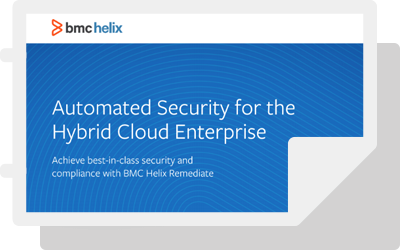In today’s multi-cloud world, organizations can’t afford to allow IT problems to disrupt or degrade service, so they must be able to proactively identify potential points of failure, address problems quickly when they do arise, and align effort with business impact. To optimally prioritize issues, IT needs to know their impact on specific applications and the business services they power with effective application monitoring. Similarly, before taking a server offline, IT needs to understand which applications will be affected in order to avoid self-inflicted damage.
Additionally, IT needs complete, reliable visibility into the complex dependencies across assets and applications with application monitoring that works. It’s critical to effective incident, change, and availability management and plays an important role in business continuity, data center and cloud transformation, planning, and compliance. But the complex and dynamic nature of multi-cloud environments makes it extremely difficult to build and maintain service maps that provide a holistic view. Without a discovery solution that is designed to capture comprehensive configuration data, build complete service maps, and maintain the accuracy of those maps, the likelihood of failed multi-cloud projects, security breaches, configuration errors, service outages, and performance degradation increases significantly.
Problems with Top-Down or Bottom-Up Approaches
Most discovery solutions use a rigid and simplistic top-down or bottom-up approach, where mapping stops as soon as the tool meets something it does not recognize. This means that users must know and specify the “top” entry point for their application or service—often a URL that leads to either a load-balanced service or to a web server. The choice of what to scan is also driven top-down, and at each stage the tool decides what to scan based upon the dependencies it detected at the previous stage.
This rigid approach poses numerous problems, including:
- The application or service entry point may not be obvious—in fact, there may be more than one. Application owners often start with the location where data is stored, which is closer to the bottom than the top.
- A dependency between two assets can often only be seen from one end can IT afford to miss dependencies that are only visible from the bottom end? A common example of twisted dependencies is a database that is also being used by a second application server. IT can’t rely on a great dependency mapping tool when the discovery is incomplete.
- If parts of an application cannot be scanned due to lack of credentials, recognition or for other reasons, the scan will just stop there and remain incomplete, leaving out valuable information.
Advantages of Start-Anywhere Application Monitoring
BMC Helix Discovery takes a proven approach with start-anywhere application monitoring that is able to identify assets and their dependencies based on any piece of information about them. There are several advantages to being able to map an application or service from any starting point:
- Users can begin mapping using whatever information they happen to know—a much more flexible, efficient and trusted experience.
- While it is inevitable that sometimes items will be missing from the discovery data due to factors such as lack of credentials, the start-anywhere approach means that all available information is mapped, on both sides of the missing item, making it easier to validate the mapping manually and allowing the system to infer the two maps in future scans.
- The flexibility to start anywhere—whether at the top, bottom, or middle—and to start in more than one place to capture additional information provides the most efficient way to close the gap on incomplete mapping.
Additionally, BMC Helix Discovery scales across the largest and most complex multi-cloud environments, including AWS and Microsoft Azure, to deliver unparalleled insight into your diverse infrastructure. It serves as a single source of information via agentless and API discovery, so you get truly multi-environment application dependency mapping. Plus, it also discovers more asset types than any other discovery and dependency mapping tool on the market—with over 4,000 asset types and counting, and new vendors and resources added every month.
With BMC Helix Discovery, you can eliminate cloud asset sprawl, understand how vulnerabilities affect applications and infrastructure, and gain the deepest insight into your environment and assets. And with the combination of flexibility, every-direction visibility, and multiple entry points, BMC Helix Discovery is the only truly effective way to map the diverse and complex applications and services that organizations need to be successful.
Multi-Cloud Success Starts with Effective Application Monitoring
Application monitoring is a critical capability for every digital business; comprehensive service mapping and discovery helps organizations to reduce errors that impact customer experience, align effort with business impact, and make informed strategic decisions about the IT environment. But most discovery solutions fail to deliver on promises of holistic visibility, relying on a rigid, top-down approach that is difficult to work with and leaves unacceptable gaps in application maps.
BMC Helix Discovery is designed to be highly scalable, flexible, fast, and easy to use, with a start-anywhere approach that provides a simple, reliable way to access critical information in real-time. Regardless of how many business services need to be mapped, their complexity, or how frequently they change, the unique approach of BMC to application monitoring is designed to help organizations of all types and sizes to prioritize issues and problem resolution based on business needs, avoid configuration errors, and proceed confidently with multi-cloud transformation initiatives.







